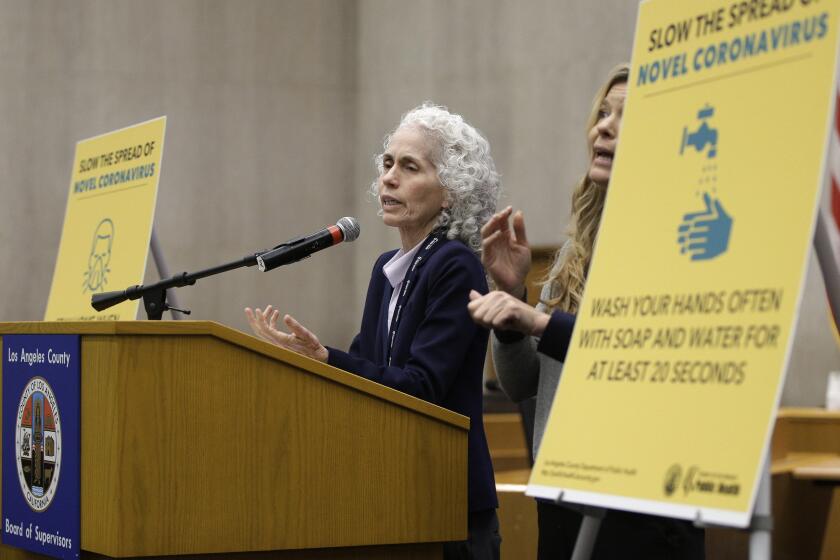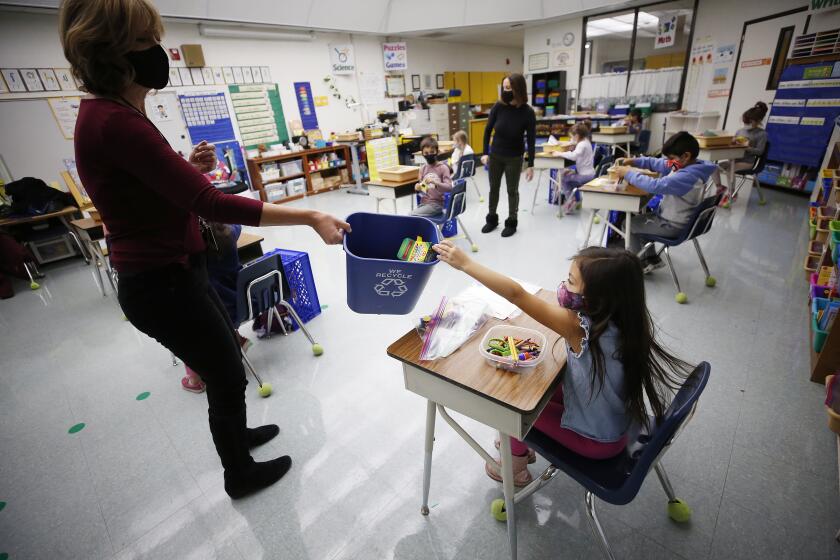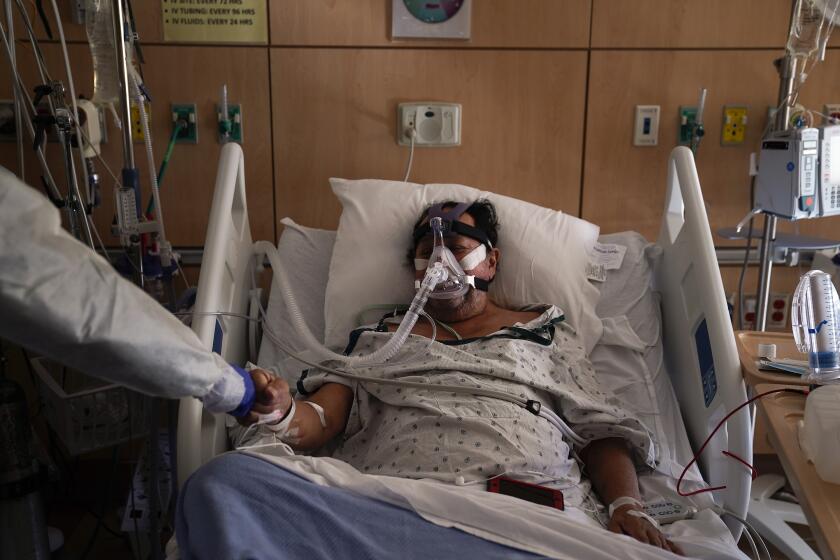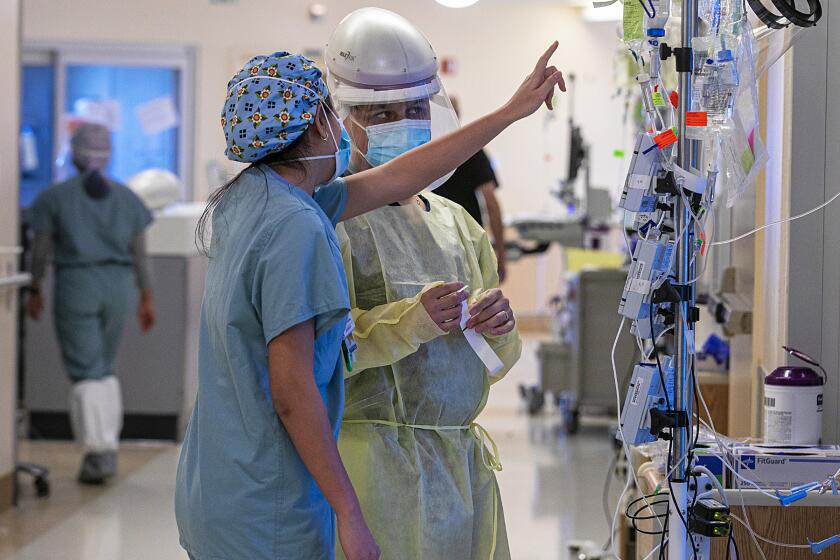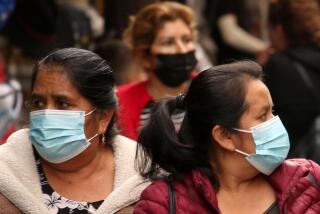1 in 5 coronavirus tests are positive in L.A. County, pointing to tough weeks ahead
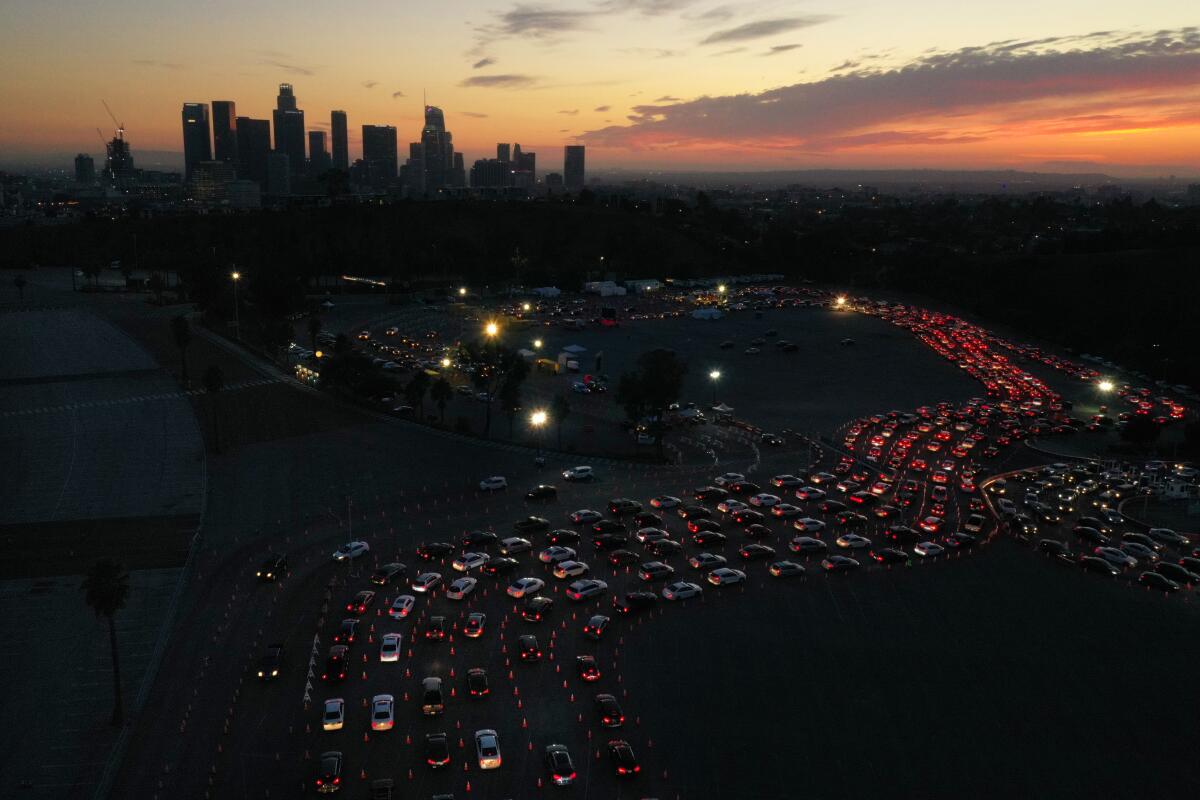
- Share via
About 1 in 5 coronavirus tests performed daily in Los Angeles County are coming back positive, an astounding rate that officials say illustrates the pandemic’s continued rampage through the region and foreshadows grave consequences for an already beleaguered healthcare system.
Around Nov. 1, roughly the starting point of the current coronavirus wave, only about 1 of every 25 tests confirmed an infection.
Officials warn that the arithmetic is as grim as it is simple. When such a high proportion of people are testing positive and tens of thousands of tests are conducted a day, case counts end up staggeringly high. And when community transmission is this prolific, officials warn that activities that seemed mundane months ago now carry a higher risk of infection than ever.
Worried public health officials said the region was losing its battle against COVID-19, adding that only immediate and decisive changes can prevent a steep rise in deaths.
L.A. County on Thursday recorded its fourth-highest number of coronavirus cases in a single day, according to a Times tally of local health jurisdictions, possibly an early sign of the surge of new cases connected to Christmas gatherings.
On Thursday, 18,764 new cases were reported, well above the daily average over the last week, which was about 14,000. There were 205 COVID-19 deaths, according to The Times’ tally, the sixth-highest single-day death toll. L.A. County is now averaging 171 deaths a day over the past week.
These figures “can be numbing,” Mayor Eric Garcetti acknowledged, but he emphasized that the number of hospitalizations represents a threefold increase from a month ago and the most in a single day since the pandemic began.
California posted at least 37,000 new coronavirus cases Thursday, continuing a trend over the last week in which the statewide daily total has flattened at about 39,000. That’s modestly less than the peak in mid-December, when California was reporting as many as 45,000 new cases a day.
Garcetti, however, cautioned against viewing this leveling out as a “plateau that will automatically come down.”
“It’s my belief this is just a pause before a new peak,” he said.
Experts fear that the counts will begin to systematically rise by the end of the week, as people who were exposed to the virus over Christmas or New Year’s begin to fall ill and get tested. Though many of those infected may experience only minor symptoms, or none at all, officials have long warned that the daily caseload is only the start of a disastrous domino effect.
A certain proportion of those testing positive — state officials have estimated about 12% — will fall ill enough to require hospitalization in the weeks following their exposure. And 12% of those people will worsen to the point they need intensive care. Some won’t survive.
High numbers of cases on the front end will invariably lead to more suffering and grief down the line.
“If the transmission within Los Angeles County, as we suspect it probably did, increased over the holidays, then we will experience an increase in hospitalizations,” Dr. Christina Ghaly, the county’s director of health services, said this week.
The reality of the pandemic has seriously hampered plans to reopen California schools as district leaders say they need clear guidance from the state.
Conditions across L.A. County’s healthcare system are already bleak.
Hospitals are reporting significant shortages of staff because so many employees are out sick or in quarantine. Officials have warned they’re running short of available ambulances, with emergency rooms so full that transport vehicles must wait hours to drop off patients — forcing those calling 911 to wait even longer for paramedics and emergency medical technicians to arrive.
Even supplies of lifesaving oxygen have been stretched thin both by overwhelming need and problems with aging hospital infrastructures.
L.A. County Emergency Medical Services Agency Director Cathy Chidester said Thursday that there continues to be a shortage of oxygen canisters that are needed to send recovering COVID-19 patients home from the hospital, which would help free up beds.
Some hospitals’ aging oxygen distribution systems, which began to fail recently in a number of hospitals due to age and freezing amid the unprecedented demand for oxygen, have been temporarily stabilized.
“But they need to be fixed,” Chidester said. The U.S. Army Corps of Engineers is investigating problems at 11 Southern California hospitals for infrastructure problems that need to be quickly addressed.
The hospital has convened a triage team that will make the ‘difficult, but necessary decisions’ about allocating resources to critically ill patients.
Staffed beds in ICUs across L.A. County are essentially filled beyond capacity, forcing critically ill patients to be treated in areas not normally designed for them, such as recovery rooms.
As of Wednesday, 1,635 coronavirus-positive patients were in intensive care countywide — seven more patients than the day before and triple the number from Thanksgiving, according to state data released Thursday.
On Tuesday, the overall number of COVID-19 hospitalizations in L.A. County climbed to a new record: 8,098. The number dipped slightly Wednesday, to 8,074, but the numbers are quadruple those from Thanksgiving. .
Over the last few days, the net daily increase in COVID-19 hospitalizations in L.A. County has been roughly 100, down from about 220 in mid-December.
“Hospitals continue to be inundated with COVID patients,” Ghaly said. “While the numbers are plateauing somewhat, they’re doing so at a rate that is well above our point of comfort for all hospitals — particularly when we’re facing another potential surge in the next couple of weeks.”
The real picture of how the rest of January will fare will start to emerge next week, where hospitalization numbers will offer the first hint of how badly the rest of the month will go.
According to The Times tracker, 1 of every 16 people in the state has tested positive for the virus at some point during the pandemic.
Hospitals across the state have been asked by officials to come up with plans for “crisis standards of care” that would be implemented when healthcare facilities are so overwhelmed they have to start prioritizing resources based on how likely patients are to survive.
Four hospitals have notified the California Department of Public Health “that they were approaching or entering crisis care at a given point in time,” according to a statement provided Thursday.
“These hospitals received immediate support and technical assistance, improving conditions to better care for patients,” the statement said. “No counties have reported that they are rationing lifesaving care or supplies.”
The state agency declined to name the hospitals, saying doing so could discourage “these critical notifications” or “individuals in the community from seeking lifesaving care.”
Methodist Hospital of Southern California in Arcadia notified the state Dec. 29 that it would implement crisis care guidelines. That hospital recently took the grim step of convening a triage team to make decisions about potentially allocating limited resources, but officials there said Wednesday they had not yet had to ration any care.
Methodist, however, has not notified the county that it has have implemented crisis standards of care.
An additional 560 COVID-19 deaths among Californians were reported Wednesday, just under the single-day record of 575 that was reported on New Year’s Eve, according to a Times tally of local health jurisdictions. At least 451 additional deaths were reported Thursday, according to a preliminary tally.
California has been averaging between 330 to 390 deaths a day recently, and L.A. County, between 150 to 190 deaths a day.
The rising death toll is overwhelming funeral homes and causing state officials to dispatch refrigerated trucks across California to hold corpses as hospital morgues fill up. The National Guard has been called to L.A. County to help with the temporary storage of bodies at the medical examiner-coroner’s office and relieve pressure on hospital morgues and private mortuaries that have run out of storage space for corpses.
Given the current conditions, and the potential for even darker days ahead, officials said the only way to beat back the pandemic is for everyone to redouble their efforts to tamp down potential transmission — and take all the precautions necessary to keep themselves and their loved ones, friends, neighbors and coworkers from becoming infected.
“While it is fair to say that the virus is out of control, I do want to remind people that it’s really up to us, as a community, of whether or not we want to get it back under control,” Ghaly said. “The gatherings at Thanksgiving have put a lot of strain on hospitals … but we can’t let that stop us, and we can’t let that make us defeatist. We have the power to get this virus under control if we choose to do that, and it’s really up to us.”
More to Read
Sign up for Essential California
The most important California stories and recommendations in your inbox every morning.
You may occasionally receive promotional content from the Los Angeles Times.
